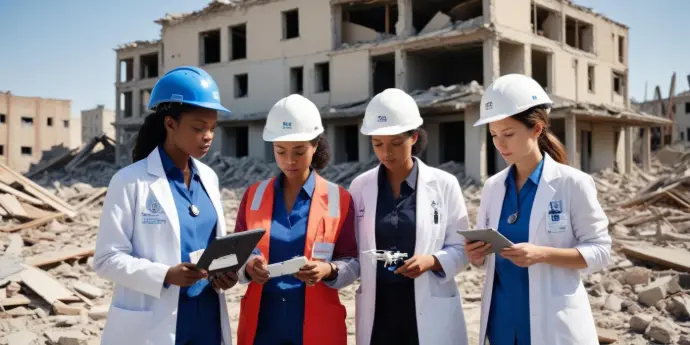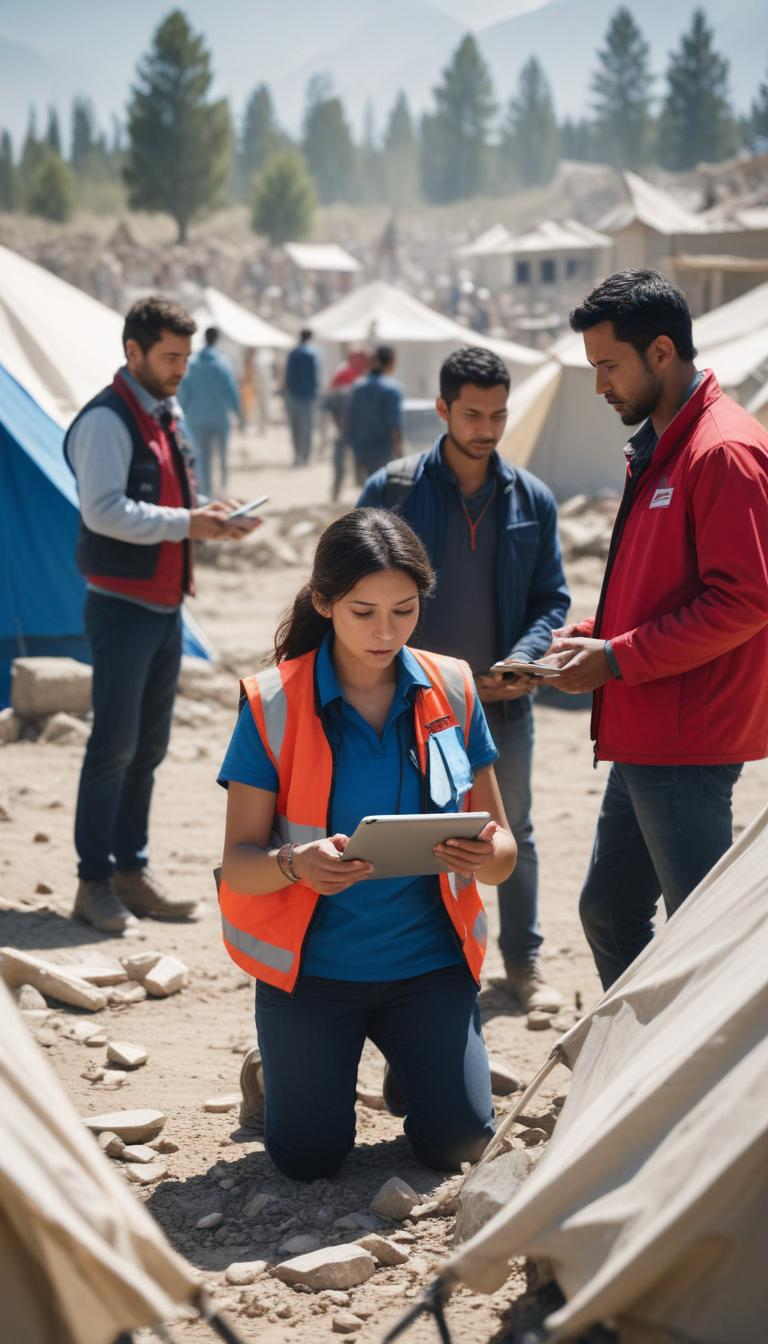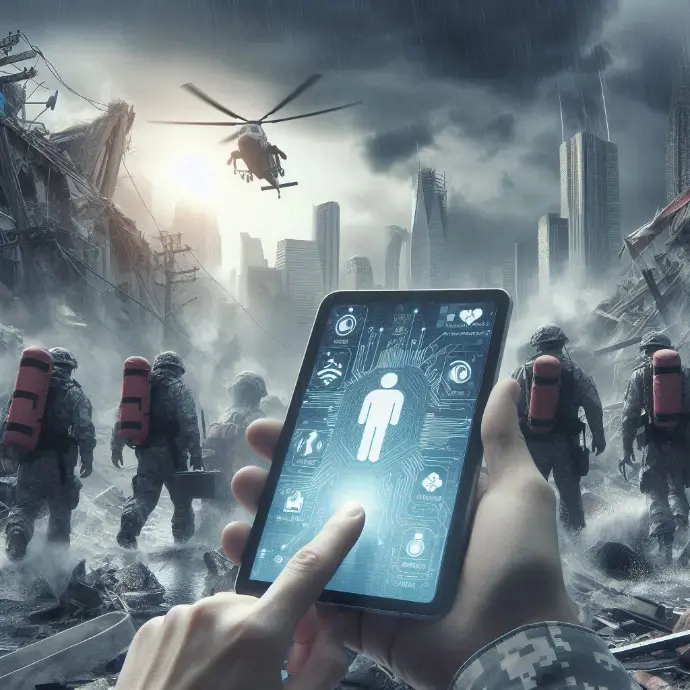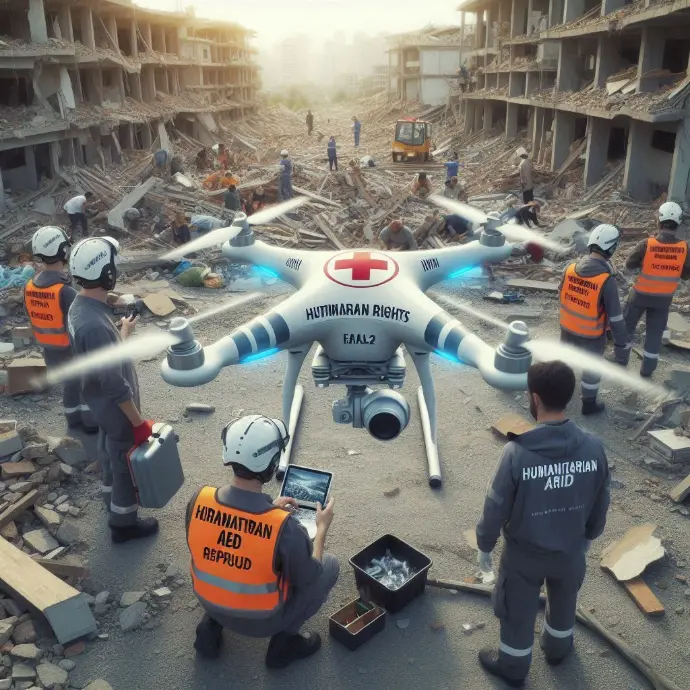

The Role of AI in Humanitarian Assistance and the Protection of Human Rights


Here you will find a space dedicated to the exploration and detailed analysis of human rights at the global level. In our main article, "The Role of AI in Humanitarian Assistance and the Protection of Human Rights," you will immerse yourself in the fascinating world of artificial intelligence applied to the defense of fundamental rights. Are you ready to discover how technology can be an ally in the fight for justice and dignity? Go ahead, the adventure is just beginning!
Introduction
Artificial intelligence (AI) has had a significant impact on the protection of human rights globally, transforming the way these fundamental issues are addressed and defended. As technology continues to evolve, AI has proven to be a valuable tool in humanitarian assistance, offering innovative advancements that improve the efficiency and effectiveness of initiatives aimed at protecting human rights around the world. Below, we will explore in detail the impact of AI on the protection of human rights, its role in humanitarian assistance globally, and the technological advancements that are driving the application of AI in this crucial area.
AI has revolutionized the way human rights issues are addressed, enabling more comprehensive analysis and more effective responses to situations of rights violations. Through massive data processing, AI can identify patterns and trends that might otherwise go unnoticed, resulting in faster detection of potential human rights violations. Furthermore, AI facilitates the collection and analysis of complex information from diverse sources, improving the ability to understand human rights needs and challenges in different contexts.
The application of AI algorithms in human rights surveillance and monitoring has also proven to be an invaluable tool, as it can analyze large volumes of data, including images and videos, to identify potential human rights violations. This rapid and accurate analysis capability enables a more immediate and effective response to violations, contributing to the protection of human rights in real time.
Furthermore, AI is being used to improve the effectiveness of legal and judicial systems in protecting human rights by offering predictive analytics that can identify potential biases or deficiencies in the administration of justice. This allows for proactively addressing systemic shortcomings, ensuring greater equity and fairness in the protection of human rights for all individuals.
AI plays a crucial role in global humanitarian assistance, improving response capacity to humanitarian crises and natural disasters. By analyzing real-time data, AI can more accurately predict and assess humanitarian needs, enabling more efficient resource allocation and a more coordinated and effective response to emergency situations.
Furthermore, AI is being used to optimize the logistics and distribution of humanitarian aid, improving route planning, inventory management, and the coordination of efforts among multiple humanitarian actors. This has led to a significant improvement in the operational efficiency of humanitarian operations, which in turn has allowed more people in need to be reached more quickly and effectively.
AI's ability to analyze large amounts of data has also improved the evaluation and monitoring capacity of humanitarian programs, enabling greater transparency and accountability in the use of resources allocated for humanitarian assistance. This has contributed to greater effectiveness in the delivery of humanitarian services, as well as more informed and evidence-based decision-making.
Technological advances in the application of AI in human rights continue to evolve, with the development of more sophisticated algorithms and the integration of emerging technologies such as machine learning and natural language processing. These advances are expanding AI's capabilities to more effectively understand and address human rights challenges, including identifying online hate speech, detecting cases of human trafficking, and preventing gender-based violence.
In addition, AI is being used to develop translation and language analysis tools that facilitate the collection and understanding of information in multilingual contexts, improving the response capacity to human rights violations in diverse communities and across diverse geographic regions.
The development of AI-based mobile applications and online platforms is also enabling greater citizen participation in the protection of human rights by providing channels for reporting violations and disseminating relevant information. These tools are empowering communities to advocate for their own rights and contribute to the protection of human rights at the local and global levels.
Background of AI in Humanitarian Assistance and Human Rights
The history of artificial intelligence (AI) in human rights protection dates back several decades, with significant advances in data analysis and pattern identification. As technology has evolved, AI has played a pivotal role in identifying human rights violations, detecting patterns of discrimination, and improving early warning systems for humanitarian crises.
The development of AI has been instrumental in expanding the capacity to monitor and respond to human rights violations worldwide. Through advanced algorithms and the analysis of large volumes of data, AI has made it possible to identify trends and risks to human rights on an unprecedented scale, providing the possibility of more effective and timely intervention.
The evolution of AI in human rights protection has been marked by significant advances in natural language processing, image recognition, and machine learning capabilities, enabling deeper and more comprehensive analysis of situations affecting communities around the world.
The development of artificial intelligence in humanitarian assistance has undergone a significant transformation over time. From the application of AI algorithms for predicting natural disasters to the use of machine learning systems to optimize the distribution of humanitarian aid, AI has revolutionized the way humanitarian crises are addressed worldwide.
AI's ability to analyze large geospatial data sets has enabled more effective planning and faster response to natural disasters, resulting in a significant reduction in human and material losses. Furthermore, AI has improved the efficiency of humanitarian assistance delivery by proactively predicting and managing the needs of communities affected by humanitarian crises.
The continued development of AI in humanitarian assistance has led to innovations in coordinating relief efforts, assessing needs, and identifying vulnerable populations, strengthening humanitarian organizations' ability to deliver more effective and needs-oriented aid.
The impact of artificial intelligence on human rights defense worldwide has been significant, providing new tools and capabilities to monitor, document, and respond to human rights violations in real time. AI has been instrumental in identifying patterns of abuse, discrimination, and violence, enabling a more effective response by the international community and human rights organizations.
Furthermore, AI has improved the ability to analyze and understand large volumes of human rights-related information, making it easier to identify trends, predict crises, and formulate preventive strategies. This has led to increased awareness and action for the protection of human rights in various regions of the world.
AI has had a significant impact on human rights defense worldwide by providing advanced tools for identifying, documenting, and responding to human rights violations, which has contributed to strengthening human rights protection worldwide.
Practical Applications of Artificial Intelligence in the Protection of Human Rights
Artificial Intelligence (AI) has proven to be an invaluable tool in identifying and preventing human rights violations around the world. Through constant monitoring and data collection, AI has enabled human rights organizations to more efficiently identify risk situations and take preventive measures.
Thanks to advanced AI algorithms, it is possible to analyze large volumes of information from various sources, such as social media, government reports, and witness testimonies. This analytical capability makes it possible to detect patterns and trends in human rights violations on a scale previously unimaginable.
AI also plays a critical role in identifying patterns and trends in human rights violations globally. By processing vast amounts of data, AI can identify meaningful correlations that help understand the underlying causes of human rights violations, which in turn enables a more effective response by human rights organizations and international bodies.
In conflict zones, AI has proven to be a crucial tool for improving the efficiency and effectiveness of humanitarian assistance. AI algorithms can analyze real-time data to identify areas of need and optimize resource distribution, allowing humanitarian organizations to reach affected populations more quickly and accurately.
Furthermore, AI can be used to predict and prevent humanitarian crises by analyzing demographic, epidemiological, and environmental data. This predictive capability allows humanitarian organizations to anticipate the needs of affected populations and take proactive measures to mitigate the impact of natural disasters, armed conflicts, and other humanitarian crises.
The development of Artificial Intelligence (AI) technologies has opened up new possibilities for the protection of vulnerable groups around the world. AI has been used to analyze large volumes of human rights-related data, enabling trends to be identified, crises to be predicted, and preventive measures to be taken to protect at-risk communities. For example, AI algorithms have been developed that can monitor patterns of discrimination, identify conflict zones, and predict population displacement, helping human rights organizations and humanitarian agencies take proactive measures to protect vulnerable groups.
Furthermore, AI has been used to improve the efficiency of humanitarian resource distribution, allowing for more effective access to communities in crisis. By analyzing demographic, health, and security data, AI systems can optimize logistics and resource allocation, ensuring that humanitarian aid reaches those most in need in a timely manner. This faster and more accurate response capability has made a significant difference in the protection of vulnerable groups in emergency situations.
The development of AI technologies has revolutionized how challenges in protecting vulnerable groups are addressed. The ability to analyze large amounts of data, predict crises, and optimize resource allocation has strengthened the work of human rights defenders and humanitarian organizations, enabling them to act more effectively in protecting the fundamental rights of people in vulnerable situations.


Challenges and Ethical Considerations in the Implementation of AI in Human Rights
In the implementation of Artificial Intelligence (AI) in the protection of human rights, a number of challenges and ethical considerations arise that must be carefully addressed. One of the potential risks of AI in this context is the possibility of algorithmic biases.
Since AI systems learn from historical datasets, there is a potential for them to reflect and perpetuate existing biases. This could result in discriminatory or unfair decisions, which goes against fundamental human rights principles. It is crucial to implement measures to identify and mitigate these biases, as well as to ensure transparency in the development and use of AI algorithms for the protection of human rights. Another major challenge is privacy and data protection.
AI often requires large amounts of data to function effectively, raising concerns about the collection, storage, and use of personal information. It is essential to establish clear standards and oversight mechanisms to ensure that the use of data in the context of AI respects the privacy and data protection rights of the individuals involved. Furthermore, the lack of comprehensibility and explainability of decisions made by AI systems represents a significant challenge. In the context of human rights protection, it is crucial that automated decisions be understandable and explainable, both to stakeholders and those affected by them.
Opacity in the operation of AI algorithms can undermine accountability and the ability to challenge unfair or harmful decisions. While AI has the potential to enhance human rights protection, it is critical to proactively address potential risks and limitations. This requires an ethical and thoughtful approach that considers fairness, transparency, and accountability in the implementation of AI in the field of human rights.
The Future of AI in Humanitarian Assistance and Human Rights Protection
Artificial intelligence (AI) is revolutionizing the way human rights are addressed globally. The application of AI in this field is expected to bring significant innovations in the identification and prevention of human rights violations. Technological advances are enabling the development of AI systems capable of analyzing large volumes of data to identify patterns and trends that may indicate potential human rights violations. AI is also expected to facilitate the identification of high-risk areas and the efficient allocation of resources for human rights protection.
Furthermore, AI is anticipated to contribute to the improvement of the collection and analysis of human rights-related data, allowing for a deeper understanding of the problems and needs of vulnerable populations around the world. This advanced analytics capability will offer human rights defenders and humanitarian organizations the ability to make more informed and effective decisions in the protection of people's fundamental rights.
The expected advances in the application of AI in human rights represent an exciting opportunity to strengthen the defense and protection of human rights worldwide, through the implementation of innovative technologies that can make a significant difference in people's lives.
The transformative potential of artificial intelligence in global human rights defense is undeniable. AI's ability to analyze large-scale data and detect complex patterns can provide unprecedented insight into human rights violations, facilitating the early identification of risk situations and the adoption of preventive measures.
Furthermore, AI can play a crucial role in the protection of human rights by helping to predict and mitigate humanitarian crises, facilitating the efficient distribution of aid in emergency situations, and improving the response capacity to natural disasters and conflicts. The application of AI in human rights advocacy has the potential to save lives and protect vulnerable communities around the world.
Furthermore, AI can be a powerful tool to amplify the voices of those facing human rights violations by enabling the collection and analysis of testimonies, reports, and data that support allegations of abuse. This can contribute to accountability and the pursuit of justice for victims of human rights violations.
Despite the opportunities offered by integrating AI in humanitarian assistance, there are also significant challenges that must be addressed. One of the key challenges lies in the need to ensure that AI is used ethically and responsibly in the protection of human rights, avoiding bias and discrimination. It is critical to establish robust regulatory and ethical frameworks to guide the development and implementation of AI in the humanitarian field.
Furthermore, the integration of AI into humanitarian assistance raises the need to develop technical and training capacities to ensure that those working in this field can use AI effectively and understand its ethical and social implications. Collaboration between humanitarian actors, AI experts, and human rights advocates will be crucial to fully realize the potential of AI in protecting human rights globally.
Amid these challenges, exciting opportunities exist to harness the transformative power of AI in humanitarian assistance, enhancing the ability to prevent human rights violations, respond to humanitarian crises, and protect vulnerable communities around the world.
Conclusion
Artificial Intelligence (AI) has proven to have a significant impact on the protection of human rights globally. Through the analysis of large volumes of data, AI can identify patterns and trends that help predict and prevent human rights violations. For example, in the field of surveillance, AI can detect suspicious activity and alert relevant authorities to prevent potential human rights violations.
Furthermore, AI has also been used to improve the efficiency of humanitarian assistance delivery. Through machine learning algorithms, the distribution of resources and the coordination of efforts in crisis situations can be optimized, allowing for more effective access to people in need.
The use of AI in the protection of human rights has also streamlined the documentation and evidence-gathering processes in cases of violations, facilitating the work of human rights defenders and international organizations.
Despite significant progress, there are pending challenges and areas for development in the application of AI in humanitarian assistance. One of the key challenges is ensuring transparency and accountability in the use of AI algorithms, especially in contexts where decisions may be made that affect people's human rights.
Another important challenge is addressing the digital divide and ensuring that AI-based technologies are accessible to all communities, especially those in vulnerable situations. Furthermore, it is essential to ensure that the development and implementation of AI in humanitarian assistance respect ethical and human rights principles, avoiding potential bias or algorithmic discrimination.
In terms of development, further work is needed to refine AI models for the early detection of human rights violations, as well as to improve interoperability between systems for more effective coordination in humanitarian crisis situations.
As technology continues to evolve, the role of AI in advancing human rights protection will remain crucial. AI is expected to play an increasingly important role in conflict prevention, disaster mitigation, and ensuring human rights protection in complex environments.
Furthermore, the development of ethical and transparent AI systems will be critical to strengthening trust in these technologies and maximizing their positive impact on human rights protection globally. Continued dialogue between human rights experts, technology developers, and policymakers will be essential to ensure that AI is used responsibly and for the benefit of humanity.
AI has the potential to positively transform human rights protection globally, provided that outstanding challenges are effectively addressed and the ethical and responsible development of these technologies is promoted.

 IHRO NEWS
IHRO NEWS


